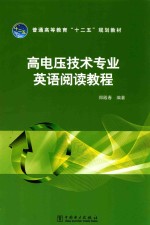

高电压技术专业英语阅读教程PDF电子书下载
- 电子书积分:9 积分如何计算积分?
- 作 者:郑殿春编著;张沛红主审
- 出 版 社:北京:中国电力出版社
- 出版年份:2015
- ISBN:9787512372658
- 页数:181 页
Unit 1 Gas Discharge Phenomena 1
1.1 Classification of Discharges 1
1.2 Current-voltage Characteristics of DC Discharge 2
1.2.1 Non-self-sustaining Discharge 3
1.2.2 Townsend Discharge 3
1.2.3 Glow Discharge 4
1.2.4 Transition to Arc Discharge 5
1.3 Townsend Breakdown 5
1.4 Production and Loss of Charges in a Gas 8
Unit 2 Non-Destructive High-voltage Tests 12
2.1 Loss in a Dielectric 12
2.2 Measurement of the Conduction Current for Direct Voltage 13
2.3 Measurement of the Dissipation Factor for Alternating Voltage 14
2.3.1 Dielectric Loss and Equivalent Circuits 14
2.3.2 Measurement with the Schering Bridge 16
2.4 Measurement of Partial Discharges at Alternating Voltages 17
2.4.1 External Partial Discharges 18
2.4.2 Internal Partial Discharges 20
Unit 3 Liquid and Composite Dielectrics 23
3.1 Liquid Characteristics 23
3.2 Solid Dielectrics 23
3.3 Composites 24
3.4 Estimation and Control of Electrical 24
3.5 Electric Fields 26
3.6 Uniform and Non-Uniform Electric Fields 26
3.7 Estimation of Electric Field in Some Geometric Boundaries 27
3.7.1 Parallel Plates 27
3.7.2 Concentric Cylinders 28
3.7.3 Parallel Cylinders of Equal Diameter 28
3.8 Surge Voltages,Their Distribution And Control 28
Unit 4 Breakdown in Air Gaps with Solid Insulating Barrier under Impulse Voltage Stress 31
4.1 Introduction 31
4.2 The First Approach for the Understanding of the Barrier Effect 32
4.3 Barriers with Opening 35
4.4 In Depth Investigation of the Breakdown Process 37
4.5 Quantitative Analysis of Spaces Charges 39
4.6 Flashover Around the Barrier without Penetration 41
4.7 Barrier Effect in Symmetric Fields 42
4.8 Investigations with Other Types of Voltages 43
4.9 Conclusions 44
Unit 5 Specialized Knowledge of Cables 46
5.1 Material Technology 46
5.2 Conductor and Insulation Screens 47
5.3 Cable Design 49
5.4 Manufacturing 50
5.5 Installation Design 51
5.6 Joints/Terminations 54
5.7 Minute Step Voltage Test 56
Unit 6 Treeing Phenomena of XLPE Cable 58
6.1 Introduction 58
6.2 Failures of XLPE Cable 58
6.3 Treeing Phenomena in XLPE Cables 60
6.4 Electrical Trees and Mechanisms 60
6.5 Water Trees and Mechanisms 62
Unit 7 Specialized Knowledge of Power Transformers 65
7.1 Features 65
7.2 Core 66
7.3 Winding 68
7.3.1 Hisercap Disk Winding(Interleaved Disk Winding) 68
7.3.2 Continuous Disk Winding 68
7.3.3 Helical Coil 69
7.4 Insulation Structure 70
7.5 Prevention of Internal Partial Discharge and Insulation 71
7.5.1 Treatment 71
7.5.2 Drying/Oil Filling Treatment 72
7.5.3 Removing Voids 72
7.5.4 Electric Field Control 72
7.5.5 Dust Control 73
7.6 Measures against Leakage Flux 73
7.7 Tank 74
7.8 Cooling System 75
7.8.1 Self-cooled Type 75
7.8.2 Air-cooled-air-cooled 76
7.8.3 Forced-oil,Forced-air-cooled Type 76
7.8.4 Forced-oil,Water-cooled Type 77
7.9 Accessories 78
7.9.1 Oil Preservation System 78
7.9.2 Diaphragm-type Oil Preservation System(Type OH-D) 78
7.9.3 Dehydrating Breather(Types FG,FP,FS) 79
7.9.4 Dial Oil Level Indicator 79
7.9.5 Protective Relays 80
7.9.6 Buchholtz Relay 80
7.9.7 Liquid Temperature Indicator 81
7.9.8 Winding Temperature Indicator Relay 81
7.9.9 Pressure Relief Device 82
7.10 Low-noise Transformer 84
7.11 Construction of Cable Connection and GIS 86
7.11.1 Connection Cable Connection 86
7.11.2 GIS(Gas Insulated Switchgear) Connection 86
7.11.3 Transportation 87
Unit 8 Investigation of Sub-Nanosecond Breakdown through Computational Methods 90
8.1 Introduction 90
8.2 Background Theory and Prior Research 91
8.2.1 Background Discharge Regimes in Pulsed Breakdown 91
8.2.2 Townsend Regime 91
8.2.3 Streamer Regime 92
8.2.4 Post Streamer Regime 93
8.3 Physical Processes in Picosecond Breakdown 94
8.3.1 Field Emission 94
8.3.2 Electron-Neutral Collisions 96
8.3.3 Runaway Electrons 97
8.3.4 Explosive Electron Emission 99
8.4 Recent Research Efforts 100
Unit 9 Numerical Simulation of Gas Discharge 106
9.1 Governing Equations 106
9.1.1 Two-Fluid Theory 107
9.1.2 Coefficients 110
9.1.3 Boundary Conditions 111
9.2 Model Equations in Dimensionless Form 112
9.2.1 Numerical Approach and Results 113
9.2.2 Grid and Discretization 113
9.2.3 θ-Method 115
9.2.4 Time Step and Iteration 116
9.2.5 Boundary Conditions and Error 117
9.3 One Dimensional Model 117
9.3.1 Thomas Algorithm and Results 120
9.3.2 Two Dimensional Model 123
9.3.3 Successive Over Relaxation Method 126
9.3.4 Results 127
9.3.5 Convergence 127
9.4 Dynamic Characteristics of SF6-N2-CO2 Gas Mixtures in DC Discharge Process 128
9.4.1 The Hybrid Computing Model 129
9.4.2 Development of the Avalanche and Streamer 132
9.4.3 Spatial Electric Field and Electron Velocity 134
9.4.4 Influence of Photoionization 135
Unit 10 Pattern Dynamics in a Two-dimensional Gas Discharge System 139
10.1 Introduction 139
10.2 Experiment 140
10.3 Model 141
10.3.1 Assumption 141
10.3.2 Specific Model 142
10.3.3 Constraint for the Constant Total Charge 144
10.3.4 Flowing Charge Density 145
10.3.5 Parameter Setting 145
10.4 Phenomena 146
10.4.1 Preparation:Behavior of Each Element Under the Global Constraint 146
10.4.2 Global Phase Diagram 147
10.4.3 DS Phase 148
10.4.4 LS Phase 149
10.4.5 Moving Spot Phase 155
10.5 Summary and Discussion 159
10.5.1 Summary 159
10.5.2 Comparison with the Experiment by Nasuno 160
10.5.3 Discussion 160
附录1 高电压技术常用词汇中英文对照 162
附录2 绝缘介质电特性中英文对照 169
附录3 美国工程索引(EI)对文摘的要求 176
参考文献 180
- 《钒产业技术及应用》高峰,彭清静,华骏主编 2019
- 《高级英语阅读与听说教程》刘秀梅编著 2019
- 《现代水泥技术发展与应用论文集》天津水泥工业设计研究院有限公司编 2019
- 《看图自学吉他弹唱教程》陈飞编著 2019
- 《激光加工实训技能指导理实一体化教程 下》王秀军,徐永红主编;刘波,刘克生副主编 2017
- 《异质性条件下技术创新最优市场结构研究 以中国高技术产业为例》千慧雄 2019
- 《AutoCAD 2019 循序渐进教程》雷焕平,吴昌松,陈兴奎主编 2019
- 《Prometheus技术秘笈》百里燊 2019
- 《少儿电子琴入门教程 双色图解版》灌木文化 2019
- 《中央财政支持提升专业服务产业发展能力项目水利工程专业课程建设成果 设施农业工程技术》赵英编 2018
- 《市政工程基础》杨岚编著 2009
- 《家畜百宝 猪、牛、羊、鸡的综合利用》山西省商业厅组织技术处编著 1959
- 《《道德经》200句》崇贤书院编著 2018
- 《高级英语阅读与听说教程》刘秀梅编著 2019
- 《计算机网络与通信基础》谢雨飞,田启川编著 2019
- 《走出人格陷阱》郑晓斌,徐樟责编;武志红 2020
- 《看图自学吉他弹唱教程》陈飞编著 2019
- 《法语词汇认知联想记忆法》刘莲编著 2020
- 《培智学校义务教育实验教科书教师教学用书 生活适应 二年级 上》人民教育出版社,课程教材研究所,特殊教育课程教材研究中心编著 2019
- 《国家社科基金项目申报规范 技巧与案例 第3版 2020》文传浩,夏宇编著 2019
- 《中国当代乡土小说文库 本乡本土》(中国)刘玉堂 2019
- 《异质性条件下技术创新最优市场结构研究 以中国高技术产业为例》千慧雄 2019
- 《中国铁路人 第三届现实主义网络文学征文大赛一等奖》恒传录著 2019
- 《莼江曲谱 2 中国昆曲博物馆藏稀见昆剧手抄曲谱汇编之一》郭腊梅主编;孙伊婷副主编;孙文明,孙伊婷编委;中国昆曲博物馆编 2018
- 《中国制造业绿色供应链发展研究报告》中国电子信息产业发展研究院 2019
- 《中国陈设艺术史》赵囡囡著 2019
- 《指向核心素养 北京十一学校名师教学设计 英语 七年级 上 配人教版》周志英总主编 2019
- 《《走近科学》精选丛书 中国UFO悬案调查》郭之文 2019
- 《清至民国中国西北戏剧经典唱段汇辑 第8卷》孔令纪 2018
- 《北京生态环境保护》《北京环境保护丛书》编委会编著 2018
